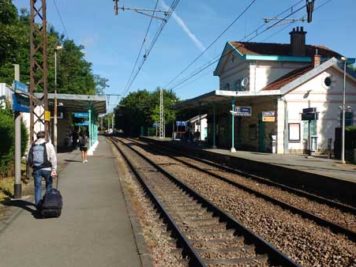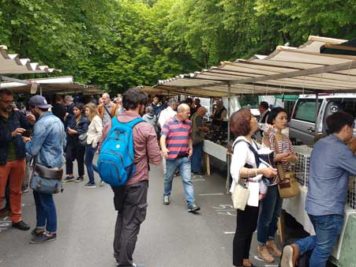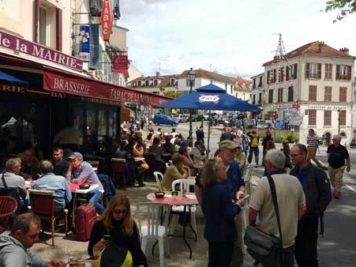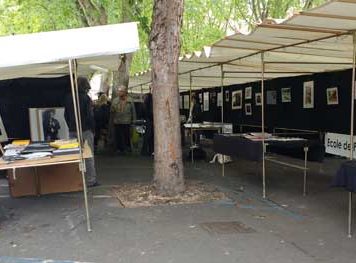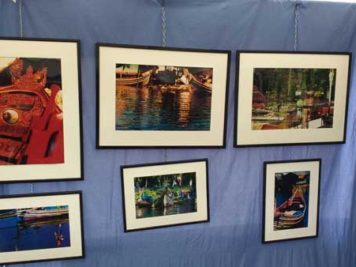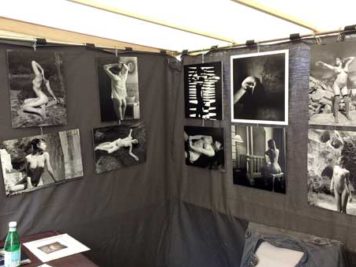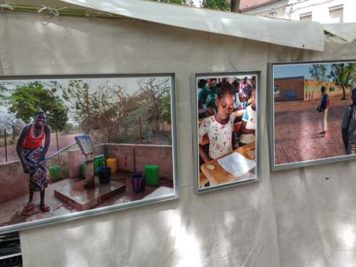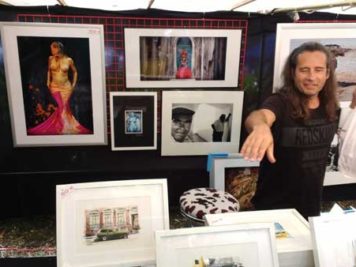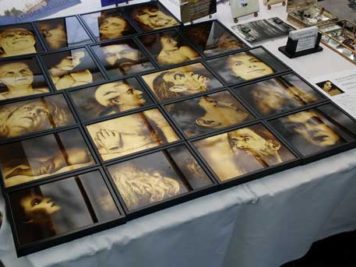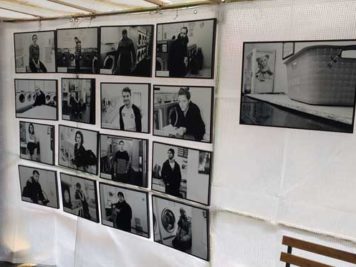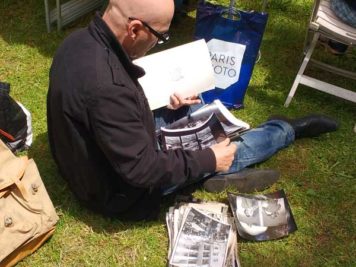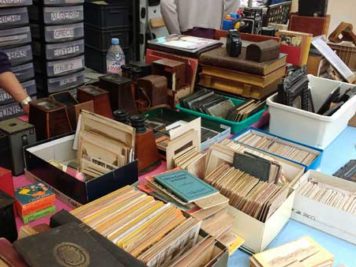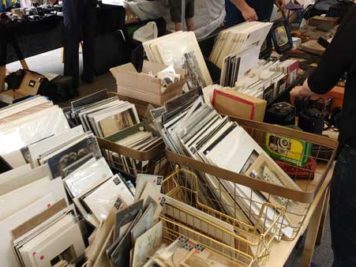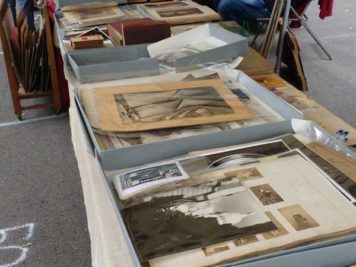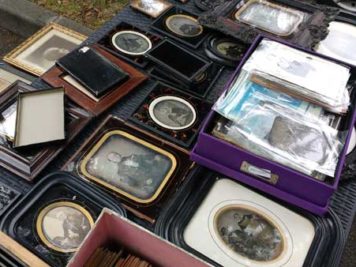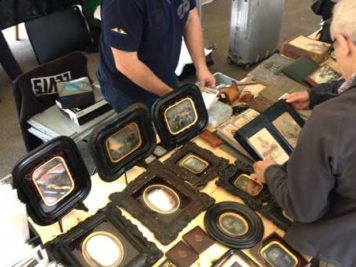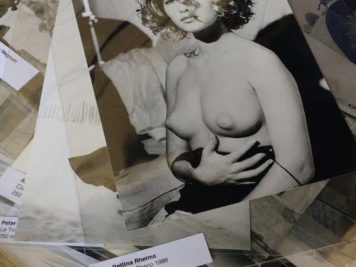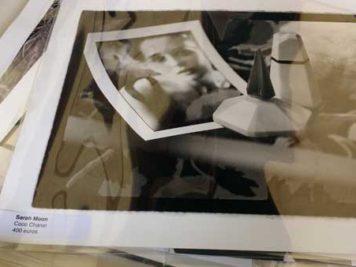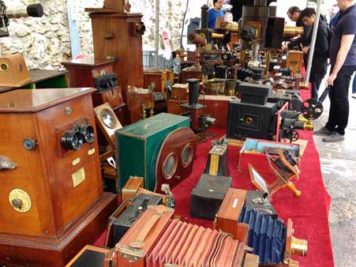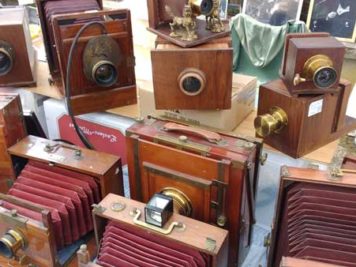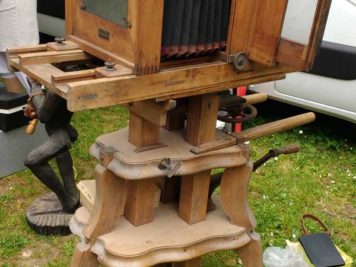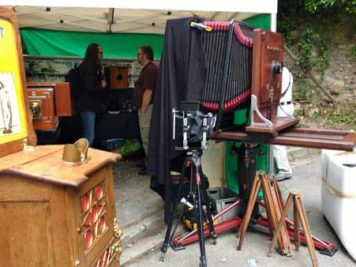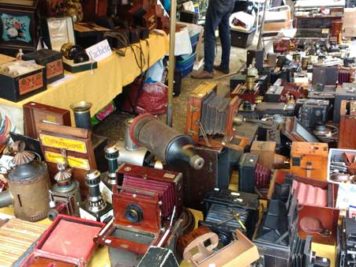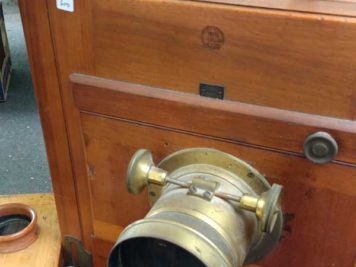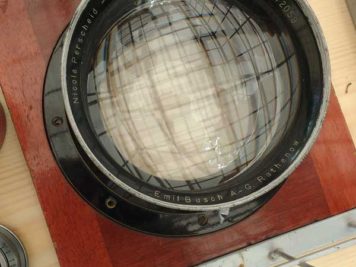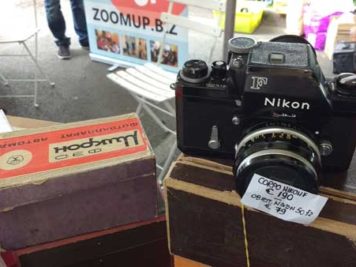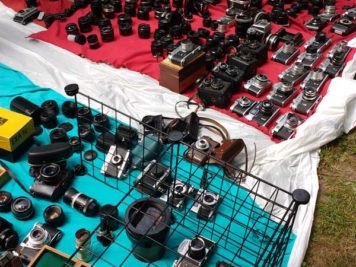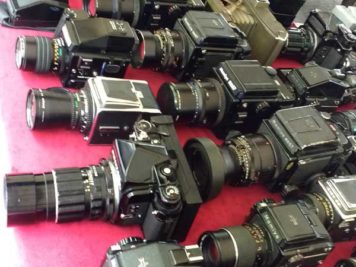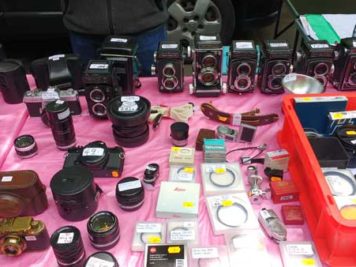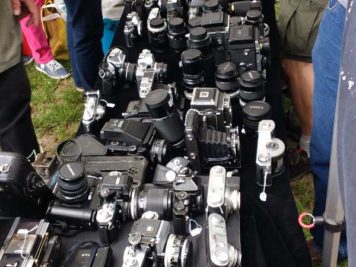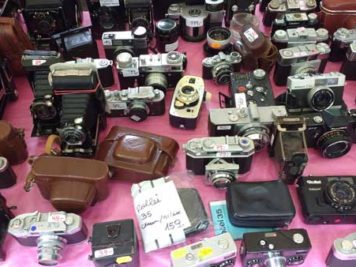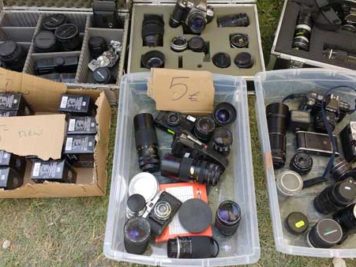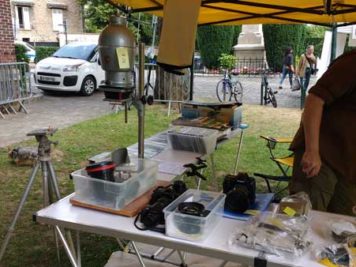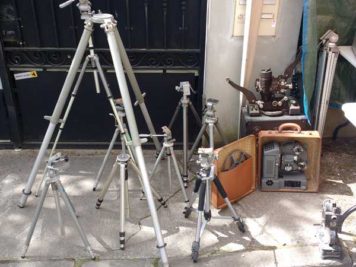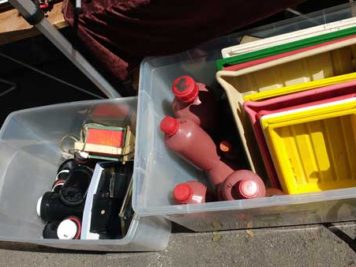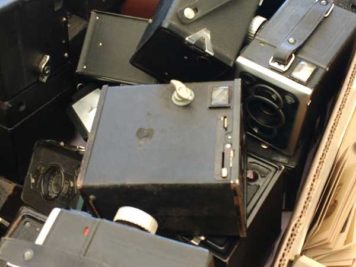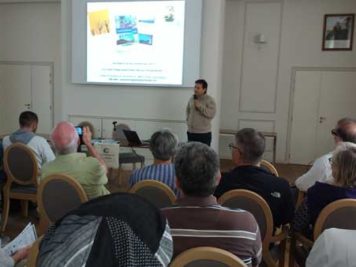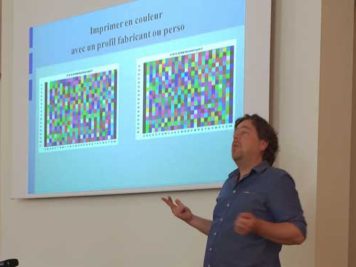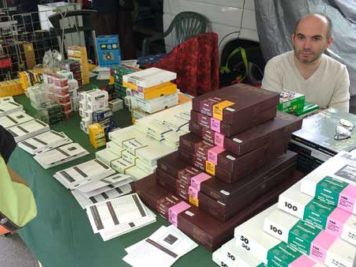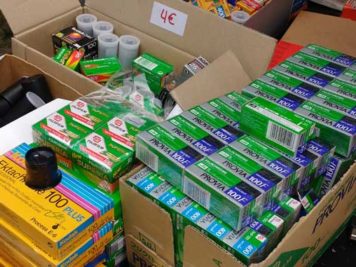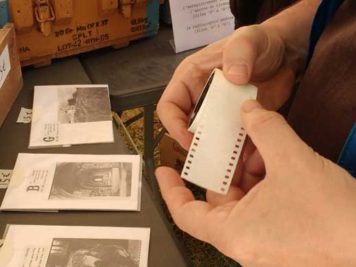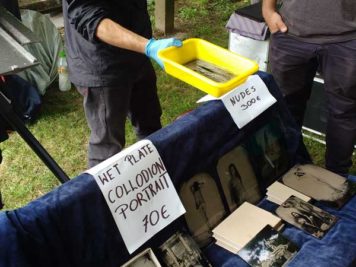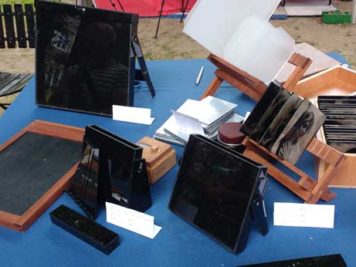After a few years without showing up, I decided to visit the 54th edition of Bièvres super fair. It is a fair organized by the Photoclub Paris Val-de-Bièvre and the Commune de Bièvres. I think my first visit was in 2002 and then I went there 6 times being the last one in 2009. I was even afraid that it would have shrunk a lot due to the raise of e-commerce on auction sites that has surely earn a big share of that trade in recent years. In fact, it’s a little smaller than what it was before, but it’s still a big party. Below, some images and comments from the 2017’s edition.
The best deal is to stay in Paris and go by train. From the D’Orsay Museum (for example), it takes about an hour. No need to arrive very early on Saturday because the fair only begins to heat up around 11 o’clock when some exhibitors have already set up their booths. The official opening hour is at 1:00 p.m. But the arrival in the small Gare de Bièvres on a fresh morning, the making of an area recognition including a coffee with croissant in a traditional boulangerie is a very nice part of the program. For lunch there are some restaurants in the town centre and one can eat very well with about 20 euros. There are also booths selling barbecue sandwiches and drinks.
It is well worth returning on Sunday as some exhibitors renew their presentation and also many individuals go there that day and spread their offerings on the lawn. Also, it is so cluttered, that going through the same tent again and again will often make you notice something you had not realized before. The exhibitors are mostly French but there are also Germans, Dutch, Eastern European, British and Americans. If you speak their language you learn a lot just out of talking, because they are all passionate about the subject.
Marché des Artistes
There is a considerable share of contemporary photography. There are around 100 photographers according to the organization of the fair and in general the artists themselves expose their pictures. It is noticeable, by expography, by the tents, that it is not “high art”. Most of what you see fits into a familiar category of correctly taken photos (same applies to a significant part of “high art” too). These are easily found in magazines specialized in photography. Lots of beautiful landscapes with photos using some tricks like super long exposures and tons of post production. Travel photos, places, people and animals in a sort of National Geographic style. In the B & W photos there seems to be a great deal of effort to show a good histogram with the whole tonal scale, from washed white to black DMax. Also graphic photos, metonymic, in which the photographer shows his accurate look at details. Also some more informed photos about what goes on in the circuit of contemporary art. In these cases the photographer has a “project”, is no longer the archetypal image hunter. This is the case, for example, of a series of portraits of people who frequent laundry shop or of old store fronts. Many wet plate pictures. They are usually without smiles and without action and with the typical marks of the process craftsmanship failures. Some resemble the Christian Boltanski style and look like concentration camp portraits. Also present the infallible “artistic nudes” in black and white. Again beautiful histograms on well-shaped bodies. Rereadings of great masters of painting and also the photographer chameleon in which each photo is a reference to some famous photographer. Anyway, it is not yet one of the strengths of the fair, but it is an interesting collection of categories that make up the imagery of our society.
Isabel Muñoz – invited artist
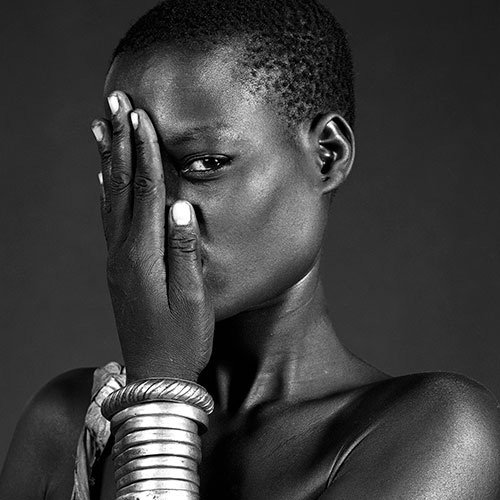
There was also a solo show featuring the artist photographer Isabel Muñoz. Born in Barcelona in 1951, Isabel has the focus of her work on the human figure. Her prints are always extremely well made and that includes the use of platinotype. World renowned, her works are Maison Européenne de la Photographie, in Paris, in the New Museum of Contemporary Art, New York City, in the Contemporary Arts Museum in Houston and many important private collections.
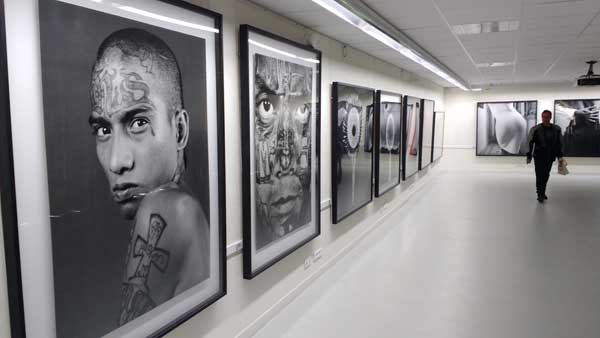
The exhibition space was a bit improvised in a hall in the basement of the city hall. The ceiling was very low and this gave even more gigantism to the prints that were far larger than the actual size. That makes more significant and valuable the effort deployed by the organization in bringing such an important artist to the fair.
Found Photo
If it is difficult today to take a picture without thinking “someone else has done it before”, the “photo found”, the one that axiomatically someone has done before, seems to have become a fairly practiced sport. It is interesting to imagine the absurdity that it would seem to someone a few decades ago to buy family photos that were not from “his” family. Well that seems pretty reasonable today and Bièvres is the ideal place if you like digging up somebody else’s memories. There are certainly thousands of old photos in every possible technique since the invention of photography. There are badly arranged packs spread on the floor and also well-organized exhibitors with catalogs and knowledge about the subject. Daguerreotypes can be bought from 40 euros onwards. Silver gelatin photos start in the cents and one should always bargain. Bargaining is like a rule of the fair.
In addition to anonymous photos there are also photos of famous people. I saw Sarah Moon, Bettina Rheims and even the famous Albert Camus photo taken by Henri Cartier Bresson – this one was for 3,000 euros. All vintage prints. Many are smaller print sizes, press photos and proofs. Historical photos of wars and important events are also offered by the hundreds. A lot of magic lantern material, some glass slides containing little stories or didactic material in boxes on the floor and sold for a few euros. Finally, there are a lot of stereo photos in glass, paper and daguerreotypes. Many are colored manually. For this part of the fair two days are little. I saw people who arrived early on Saturday and by the end of Sunday were still tossing each of the pictures on each corner of the fair.
Wood, glass and brass – as only in Bièvres
I do not think that anywhere else in the world there is such a concentration of nineteenth-century photographic equipment for sale. It would be possible to form a museum collection in just one visit. It also impresses the variety of formats, systems and manufacturers. You can easily find the first lenses for landscape, like the achromatic doublets from manufacturers like Charles Chevalier, Lerebours & Secretan, Hermagis, Darlot, Dallmeyer. Many lenses of Petzval’s type for portraits with iconic names such as Voigtlander and Steinheil. Also cameras and wooden accessories in excellent condition. Very special, I saw two super large format cameras something like 20 x 20 inches and a lens manufactured by Emil Busch in Rathenow – Germany, bearing the name of the photographer Nicola Perscheid – that, for 2000 euros, a good price. I also saw a huge Charles Chevalier with a prism to correct the left / right inversion of the daguerreotypes.
19th century optics
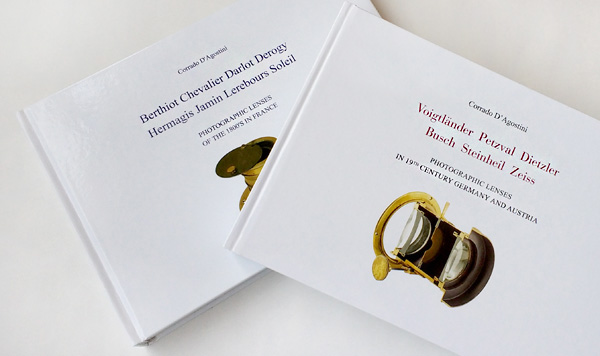

Very interesting for those who want to delve into the history of photography was the presence of the Italian collector and researcher Corrado D’Agostini. Professor of clinical psychology at the University of Florence, Corrado also studies photography, more specifically, optics from the 19th century, and brought his second book on German and Austrian lenses to the fair. The previous volume, dedicated exclusively to the French, has already become a reference in the subject and is consulted and cited as a rich and reliable source. To know more, visit the link: Corrado D’Agostini.
20th century
One could find also many lenses of the turn of the century, when so much progress was made with the new glasses of Jena and the arrival of anastigmatic. Names like Zeiss, Ross, Goerz and, advancing more in the timeline Rodenstock and Schneider. I saw a Symmar 480 mm, perfect, for 650 euros. The camera gear now includes more and more medium format, hundreds of folding cameras for sheet and roll films. In the 35 mm many unheard brands besides Leicas, A to F and also the M, hundreds of Zeiss Ikon, Voigtlanders, Agfas and all the great Japanese in telemeter and SLR. Linhofs in half plate and quarter plate.
Bièvres Soldes
Another stronghold of the fair are the boxes and carpets with photo gear of all kinds. In these cases there is usually a fixed price for any piece in the box and it can often go for less. They range from broken equipment to functional parts in need only of some cleaning. All that is needed to set up a B & W darkroom and DIY projects. The limit is what you can carry.
Lectures
There is a program of lectures during the fair. I saw a very good one about colorimetry, another about how to print well black and white photos with color digital equipment, and a third about travel photos that gave many tips on using Cokin filters. All were about digital imaging applications. Lectures were in French and without simultaneous translation.
Supplies
One can find paper for both digital and traditional darkroom B & W printing. An Ilford fiber box of 100 sheets 18 x 24 cm was 70 euros while the RC of the same size goes for 60 euros. Also fresh and expired chemicals and films at very good prices.
Alternative Processes
For the first year the fair opened space for alternative processes and wet plate photography was the highlight of the new sector. The pôle des procédés alternatifs consisted of booths selling material and some activities with photographs being taken and processed right away. Wet plate has the advantage of combining all the attractiveness of an alternative procedure with a very beautiful finish and the advantage of being able to be carried out entirely on site. It’s as good as film and fast as digital. A portrait in more or less 13×18 cm was offered by 70 euros.
Among the products for sale was the booth of Pierre-Loup Martin, of the Labodutroisieme, which manufactures tanks and accessories necessary to make the wet plate. I found very good prices for black plates in plexiglass that yield great results when used for ambrotypes. Ten plates in 4×5 ‘or 10×12 cm for 8 euros.
Another interesting exhibitor in the pôle des procédés alternatifs was the Film Washi. The way the young entrepreneurs define themselves is already delightful: “Fondé in 2013, Film Washi est la plus petite entreprise de fabrication de supports photographiques et la dernière à produire du film en France.” [Founded in 2013, Film Washi is the smallest company to manufacture photographic media and the last one still to produce films in France]. Using the famous Japanese paper, handmade, the “film” is produced in various formats, I bought 12 sheets of 4×5 ‘for 25 euros. But it is already available even in 35 mm. Nice initiative and good luck to them.
- Film Washi
- Lelabodutroisieme
Sunday, end of fair, it’s time to go to the platform to wait for the train back. And no one can wait till they get home to play with the new film camera.
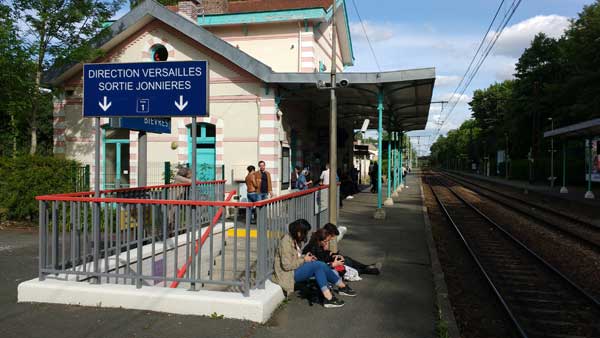
For more information, find here the official site: Bièvres.
Comment with one click:
Was this article useful for you? [ratings]
